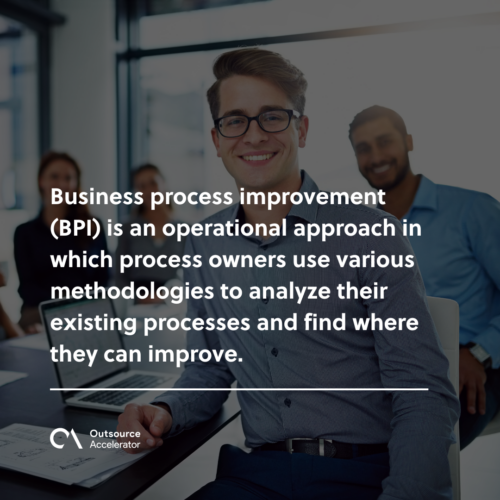Business process improvement
Definition
What is a business process improvement?
Business process improvement (BPI) is an operational approach in which process owners use various methodologies to analyze their existing processes and find where they can improve. BPI results in quality upgrades, service enhancements, cost savings, and increased productivity of the business process.
It also focuses on boosting customer satisfaction by identifying the company’s key techniques to develop an outstanding environment, listening to your customers, and selecting the appropriate tools for your business.

How to improve processes in business?
To succeed in the implementation of the business process, here are some business process improvement techniques that have shown to be beneficial in various businesses.
Six Sigma and Lean Thinking
Six Sigma provides a data-driven assessment supporting the avoidance of inconsistencies in the current workflow to function efficiently with minimal errors.
It primarily focuses on production; however, in recent years, it has developed into a broader strategy, improving different corporate activities.
Six Sigma uses data for the necessary analytics and employs financial, project management, and data analysis software. The DMAIC framework, according to Six Sigma, may be used to address any problem within a business process.
The Lean Thinking approach is one of the most innovative variations of the Six Sigma technique. When some activities do not provide value to the consumer, they must be removed.
Total quality management (TQM)
The goal of total quality management is to continuously improve internal processes to increase the quality of an organization’s outputs.
Under the TQM structure, every employee must be dedicated to ensuring good work standards in all aspects of a company’s operations.
Theory of Constraints (TOC)
The Theory of Constraints identifies the restriction that causes the bottleneck in a business process. It improves the process until its negative effect is eliminated.
The effective use of this technique increases the company’s productivity, streamlines product flow, and improves the workflow as it removes wasteful bottlenecks.
In most situations, TOC is built on the Five Focusing Steps technique, which includes identifying the bottleneck, eliminating it, aligning all other operations with the constraint’s correction, realizing alternative feasible steps to reduce the bottleneck, and moving to the new inefficiency.
Kaizen
Kaizen helps businesses in increasing productivity, simplifying work, encouraging continuous improvement, improving employee satisfaction, and enhancing product quality.
In the Kaizen process, employees stop production when they identify a problem and report it to a supervisor. The report should include recommendations for improvement.
However, it is insufficient without measurement. Management should collect operational data and compare it to expected or intended results.
Effective measurement of the present process reveals areas of underperformance. So, seek long-term solutions to the challenges listed and procedures should be changed as needed.







 Independent
Independent




